A cross-sectional study of household biomass fuel use among a periurban population in Malawi
- PMID: 24960156
- PMCID: PMC5063095
- DOI: 10.1513/AnnalsATS.201311-413OC
A cross-sectional study of household biomass fuel use among a periurban population in Malawi
Abstract
Rationale: The Global Burden of Disease Study suggests almost 3.5 million people die as a consequence of household air pollution every year. Respiratory diseases including chronic obstructive pulmonary disease and pneumonia in children are strongly associated with exposure to household air pollution. Smoke from burning biomass fuels for cooking, heating, and lighting is the main contributor to high household air pollution levels in low-income countries like Malawi. A greater understanding of biomass fuel use in Malawi should enable us to address household air pollution-associated communicable and noncommunicable diseases more effectively.
Objectives: To conduct a cross-sectional analysis of biomass fuel use and population demographics among adults in Blantyre, Malawi.
Methods: We used global positioning system-enabled personal digital assistants to collect data on location, age, sex, marital status, education, occupation, and fuel use. We describe these data and explore associations between demographics and reported fuel type.
Measurements and main results: A total of 16,079 adults participated (nine households refused); median age was 30 years, there was a similar distribution of men and women, 60% were married, and 62% received secondary school education. The most commonly reported occupation for men and women was "salaried employment" (40.7%) and "petty trader and marketing" (23.5%), respectively. Charcoal (81.5% of households), wood (36.5%), and electricity (29.1%) were the main fuels used at home. Only 3.9% of households used electricity exclusively. Lower educational and occupational attainment was associated with greater use of wood.
Conclusions: This large cross-sectional study has identified extensive use of biomass fuels in a typical sub-Saharan Africa periurban population in which women and people of lower socioeconomic status are disproportionately affected. Biomass fuel use is likely to be a major driver of existing communicable respiratory disease and the emerging noncommunicable disease (especially respiratory and cardiovascular) epidemic in this region. Our data will help inform the rationale for specific intervention studies and the development of appropriately targeted public health strategies to tackle this important and poverty-related global health problem.
Keywords: biomass fuel use; household air pollution; noncommunicable diseases.
Conflict of interest statement
Author disclosures are available with the text of this article at www.atsjournals.org.
Figures













References
-
- Lim SS, Vos T, Flaxman AD, Danaei G, Shibuya K, Adair-Rohani H, Amann M, Anderson HR, Andrews KG, Aryee M, et al. A comparative risk assessment of burden of disease and injury attributable to 67 risk factors and risk factor clusters in 21 regions, 1990-2010: a systematic analysis for the Global Burden of Disease Study 2010. Lancet. 2012;380:2224–2260. - PMC - PubMed
-
- Smith KR, Mehta S, Maeusezahl-Feuz M. Indoor air pollution from household use of solid fuels. In: Ezzati M, Lopez AD, Rodgers A, Murray CJL, editors. Comparative quantification of health risks: global and regional burden of disease attributable to selected major risk factors. 1st ed. Vol. 2. Geneva: World Health Organisation; 2004. pp. 1435–1493.
-
- Kurmi OP, Lam KB, Ayres JG. Indoor air pollution and the lung in low- and medium-income countries. Eur Respir J. 2012;40:239–254. - PubMed
Publication types
MeSH terms
Grants and funding
LinkOut - more resources
Full Text Sources
Other Literature Sources
Medical

